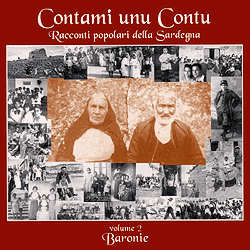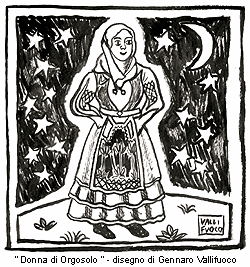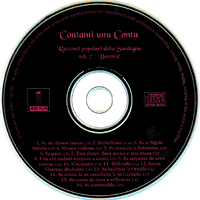

|
Home Page |

|
Go Back |

|
Versione italiana |

|
Premise |

|
Sound restoration |

|
The Tales |

|
Samples |

The fable is a composition with contents which are universal in the true sense of the word. Not only is it able to accommodate any element whatsoever, making it sublime, but it mirrors in a true fashion all the essential elements of human existence. Even the single fable usually contains both the small and the large world, private and public events, earthly and supernatural events. If we then consider four or five narration texts (any true narrator knows many), then the full nature of human possibility opens before our eyes.
Max Lüthi, The popular European

|
volume 2
A production of Archivi del Sud |
The collection Contami unu Contu. Popular tales of Sardinia edited by Archivi del Sud, inaugurated in 1996 with a disc of texts in
Logudorese, continues with this CD dedicated to the Baronie. The texts inserted in the chain all come from a corpus of Sardinian traditional tales recorded in a survey campaign promoted by the Chair for History of Popular traditions of Sardinia in the University of Cagliari. These recording were at the base of a project of sound archiving perfected and brought forth both by the lecturers at the above office (in particular Addari Rapallo and Enrica Delitala) and by the researchers of the association Archivi del Sud from Alghero (in particular Enedina Sanna and Enzo Favata). Within three years we hope to clean and re-record onto digital media all the recorded material regarding the Art of storytelling in the archive of the university and also to produce three or more explicative CD's.
This second disc regards the recuperation of recordings made in the province of Nuoro; the presence of several collections coming from a geographical area which is continuous while having some differences has led us to choose that of the Baronie area over other regions of the province which are less well represented by the corpus of texts and recordings available. For the chosen area it has been possible to choose from a selection of c. 20 hours of recordings and a base of 129 narrative texts; it is therefore obvious that the 16 texts on the CD are no more than an example of the repertory of traditional narration in the area. The time limits imposed by the disc have forced us to document only certain kinds of tale (magic tales, local and religious legends, anecdotes etc.) relating to 8 localities (Torpè Siniscola, Irgoli, Lòculi, Onifai, Galtellì, Orosei and Dorgali) and 10 narrators. Therefore this is little compared to the great narrative heritage of the popular Sardinian culture and that of the Baronie, though we would like to remind the reader that it is with this chain that genuine listening of popular tales and fables is offered for the first time, and we would like to hope that further research and publications of a scientific nature may be prompted by our initiative.
 The recordings which have been used were made in 1971 and 1974: this fact is important because both the socio-cultural environment on the whole and the use of story-telling and the use of the Sardinian language have changed greatly from that time. This historical value of the tracks is therefore one of the elements which must be reflected upon while listening to them and using them as a didactic
tool. In the years in which the research was carried out, even though the great changes of our society were taking place, the traditional world conserved many of its characteristic outlines (including the general use of local dialect) and the rural culture was quite distinct from the urban which, in turn, had little to do with the modern way of life.Even though Torpè Siniscola, Irgoli, Lòculi, Onifai, Galtellì, Orosei and Dorgali were beginning to be touched by tourist entrepreneurial activity and by industrial development, they maintained, on the whole, the traditional shepherding and craft vocations and the associated rhythms of life. In this context the conditions that led to the meeting of family, friends, neighbours or work-mates becoming spontaneous and informal narrative sessions; the absence of radio and television favoured conversation and between the darning needle and a glass of wine the silences could be interrupted by gossip, confiding, memories of life that has been lived, a story of an encounter with ghosts, a religious story, and fantastic tale. The phenomenon had certainly grown lesser in the 1970's, yet those who conducted the research had no difficulty in finding narrators who were gifted and willing to search their memories and tell before the recorders stories which had been narrated many times before, and by way of which the following were handed down from generation to generation: happenings in the community, beliefs and the knowledge that includes the capacity to maintain attention, to make people laugh or be moved, to lengthen, shorten or modify the tale according to the occasion and necessity.
The recordings which have been used were made in 1971 and 1974: this fact is important because both the socio-cultural environment on the whole and the use of story-telling and the use of the Sardinian language have changed greatly from that time. This historical value of the tracks is therefore one of the elements which must be reflected upon while listening to them and using them as a didactic
tool. In the years in which the research was carried out, even though the great changes of our society were taking place, the traditional world conserved many of its characteristic outlines (including the general use of local dialect) and the rural culture was quite distinct from the urban which, in turn, had little to do with the modern way of life.Even though Torpè Siniscola, Irgoli, Lòculi, Onifai, Galtellì, Orosei and Dorgali were beginning to be touched by tourist entrepreneurial activity and by industrial development, they maintained, on the whole, the traditional shepherding and craft vocations and the associated rhythms of life. In this context the conditions that led to the meeting of family, friends, neighbours or work-mates becoming spontaneous and informal narrative sessions; the absence of radio and television favoured conversation and between the darning needle and a glass of wine the silences could be interrupted by gossip, confiding, memories of life that has been lived, a story of an encounter with ghosts, a religious story, and fantastic tale. The phenomenon had certainly grown lesser in the 1970's, yet those who conducted the research had no difficulty in finding narrators who were gifted and willing to search their memories and tell before the recorders stories which had been narrated many times before, and by way of which the following were handed down from generation to generation: happenings in the community, beliefs and the knowledge that includes the capacity to maintain attention, to make people laugh or be moved, to lengthen, shorten or modify the tale according to the occasion and necessity.
The narrators (4 men and 6 women, most of whom were elderly and with elementary education), chosen from amongst the best of the three volumes, all have a sense of rhythm, communicative capacity, the capacity to adapt the voice and tone to the single tale and at the focal moments, to be creative and personal while respecting the plot and the narrative style codified by tradition.
The sixteen tales may be compared to the fundamental characteristics of the popular European folk tale and to plots and motifs which can be found internationally; the majority of the texts have been widely documented in the European field and can be found in the international index of folk tales conceived and edited by Anti Aarne and Stith Thompson in the sector of the diffusion theory of the Finnish school. The categorisation of tales with mainly comparative aims employed these experts for a long time at the end of the 19th and start of the 20th centuries, until the development of Formalism, which with the Soviet expert Vladimir Propp, based classification on scientific criteria, centring research on so-called magic or wonder tales, the nature of which he described.
The magic tales, that is those which are registered in the international index as numbers 300-749, are those which compose the majority of this CD (The shepherd boy and the seven-headed serpent, AT 300; Braballianu, AT 425; He who always went to church, AT 460; The two stepsisters, AT480; The story of Nicola Safatta, AT516; Saint Vincent the apprentice, AT753; Solomon's servant, AT 910). It also contains some jokes and anecdotes comprised between 1200 and 1999 in the above index (Mussin Gallone, AT 1288 and 1250; Three brothers - two who were clever and one a fool, AT 153; Riffa-riffa, AT 1562;The gravedigger of Urzulei, AT 1711)
and four texts which regard deaths, treasure, petrifaction and foundation (The ghost of the child-bearer,
The treasure, The Turks, The Castellana of Carmelo) that are not to be found in Aarne-Thompson.
In the Sardinian narrative corpus, the legend occupies a position of great importance and represents the aspect which is most local, linked as it is to places, facts and persons from everyday life, linked with a group of fantastic creatures that populate the imagination in a characterising manner, so much so that it may be spoken of, though with great caution, in ethnic terms. The Sardinian legends in general, like the four which are proposed here, develop by way of a series of motifs which are widely documented in universal narrative, organised in a way which is quite particular, in sequences which are strictly linked to local reality.
The legend of The ghost of the
Child-bearer, where the women who died during labour and returns to wash the clothes of her labour, and becomes evil if interrupted in her work (Mf E 279.6) realises the motif of the tomb without peace (Mf E 410) and illustrates one of the places privileged by apparitions, places where water flows. The motif of hidden treasure, guarded by fantastic creatures or monsters, is also very widespread (Mf H 335.3.4), these dissolve if the taboo of silence in broken (Mf C 401). It is this which is told in the legend,
The treasure, where the finding is made possible by the reading of sacred texts by the village priest.
The castellana of Carmelo is a foundation legend which illustrates the origin of the village of Dorgali; it realises the motifs of destruction by a flood (Mf A 991). In
The Turks the motif of petrifaction as a punishment is used to explain the profile of the mountains that surround Torpè (Mf A 977.5): it narrates that the Virgin- to whom the villagers had dedicated a sanctuary after having found a simulacrum on the sea shore - punished in this way the "Turks" who threatened to invade the territory.
La leggenda con i suoi contenuti didattico-edificanti organizza, entro una trama di riferimenti, la vita della comunità regolandone in qualche modo i comportamenti. Assai più libera, tersa, disancorata dall'esperienza della realtà presente, appare invece, sotto questo profilo, la fiaba di magia.
The legend with its didactic-edifying contents organises, within a web of references, the life of the community, regulating in a certain way its behaviour. Under this profile, the magic tale appears far freer, terser and disconnected from the present reality.
The texts which are proposed here are of great national and international popularity and in Sardinia they are present in numerous versions. That which is particularly noticeable about the Sardinian texts is the dry, abbreviated style, which is totally concentrated on the contents, without concessions to wonder and sentiment. This can be seen in texts of particular emotional impact such as
Braballianu and Nicola Safatta, in which episodes are realised, such as the sacrifice of the young children and the punishment of the unfaithful sister, without the narrator betraying any personal emotional participation in the facts which occur.
The sly and clever spirit of the Sardinian is displayed with the fun-loving and smug participation in the category of tales defined by Aarne and Thompson as "Jokes and Anecdotes":
The gravedigger of Urzulei, Three
brothers - two who were clever and one a fool, Riffa-riffa, are
an effective example of the satisfaction that the narrator expresses for the
triumph of cleverness over the presumed pedantry of those who claim to
retain power and intelligence in an exclusive manner. In the same way, in
tales such as Mussin Gallone, the pleasure of illustrating with
exhilarating happenings the popular monuments with which they are
consecrated, handing down to posterity the de-qualifying characters of the
surrounding populations.
Chiarella Addari Rapallo
Enrica Delitala
Annotations on sound restoration
The professional techniques of sound recording in the sixties and seventies had a typical characteristic flatness, so that they left little possibility for the environment and that which is today called "Three-dimension sound" was impossible to obtain with normal recorders, even less in non-professional situations such as those in which the documents we recovered were recorded.
In the initial phase the majority of the documents presented defects caused by demagnetisation, loss of the presence of the acoustic signal and a consequential difficulty in listening.
The first temptation was that of reconstructing the missing pieces of the sound signal and to give splendour and presence to the voices, eliminating totally all hums and noises of any kind: to renovate, following our modern taste regarding listening, the documents which on first being heard appeared so disturbed and flat.
The restoration processes, with the software and hardware means at our disposal, would not have created great difficulty, but at the moment of starting work, a particular episode suggested I take another path: like all the music-lovers and musicians of my generation I have a notable quantity of vinyl discs that I have listened to for years and to which many memories and my artistic formation are linked: at the dawn of the CD I abandoned them, attracted by the perfection of the new means, an abandonment favoured also by the breaking down of an old record player, worn away by the great amount of work it had done. It was, therefore, a total break, for a long period, with that world of sound.
After ten years, for reasons linked to study, I had to return to listening to music on those old LPs: the record player was repaired, I started listening and had a surprise: the sound, immobile and forgotten for so long, had maintained a characteristic colour, that acoustic imperfection, that dark and warm sound, and the familiar background sound of the wearing down of the needle within the grooves, the scratches that made the needle jump....that music was so beautiful, on those means that were so imperfect and eroded by time, strangely enough these were its strength.
This episode made me meditate upon the intervention for the folk tales, and besides I had got hold of the restoration paper of 1972 regarding the restoration and safeguarding of monuments and works of art, of which an extract is given below:
In relation to the ends to which the operations of safeguarding and restoration must correspond, the following are categorically prohibited for all works of art:
1) Completions in style and analogy, even in simplified form and even if
there are graphic or plastic documents that may indicate what the final work
looked like or how it should have appeared.
2) Removal or demolition which cancel the passage of the work through time,
unless it regards limited alterations which are disturbing or incompatible
with the historical value of the work or completion in style which falsifies
the very work.
3) Alteration or removal of the surface alteration due to time.
All this directed me towards a choice which was different to the initial one: the documents had to remain intact in their original characteristic timbre; the 'restoration' intervention should guarantee exclusively the maintenance of the acoustic signal, in relation to its legibility and in relation to the new type of medium, the digital.
After the realisation of two CDs in the chain Contami unu Contu and after having re-recorded c. 100 hours of material, the choice turned out to be the most reasonable, shared by other research centres and recording studios, with which we have compared our different experience in a field which is new and therefore full of traps.
Finally one of the characteristics of our memory is that of remembering things in a vague and imprecise way, without always being able to focus on episodes which are distant in time: why then should we modify this fascinating loss of information? We must be patient: the memory is a bit like an old record that scratches, more attention must be paid when listening and conserving it
.
Enzo Favata
Archivi del Sud
The tales
 The tales of the Baronie
The tales of the Baronie
1. Sa ria dessos turcos (2.01)
2. Braballianu (11.44)
3. Sa 'e Nigola Safatta (8.47)
4. Mussin Gallone (3.20)
5. Su teraccu 'e Solomone (4.34)
6. Sa pana (0.54)
7. Tres frates, duos savios e unu macu (5.27)
8. Unu chi andaiti sempere a cresia (4.30)
9. Sa serpente de sette concas (6.42)
10. S'iscusoriu (2.40)
11. Riffi-raffa (3.42)
12. Santu Vissente dischente (2.46)
13. Su bechinu 'e Ortullè (0.42)
14. Su contu de sa castellana 'e su Carmelo (2.07)
15. Su contu de duas sorellastras (2.42)
16. Su pastoreddu (3.54)
Click here for read or Listen some tracks in Real Audio
![]()